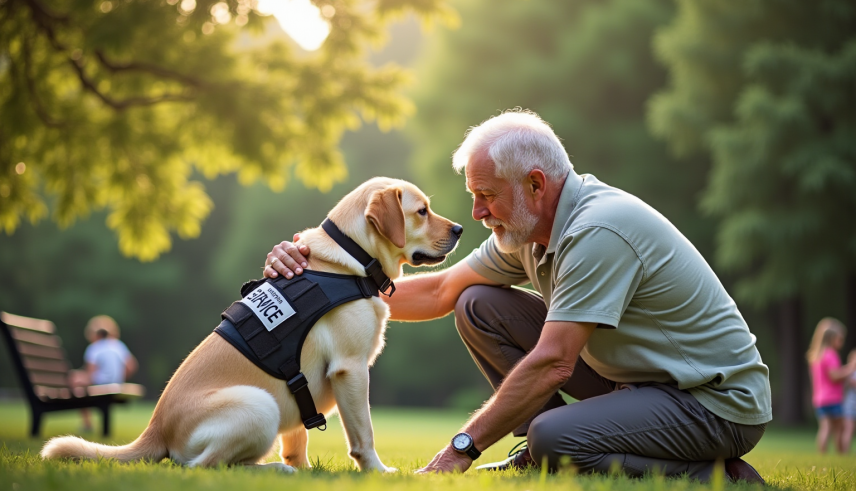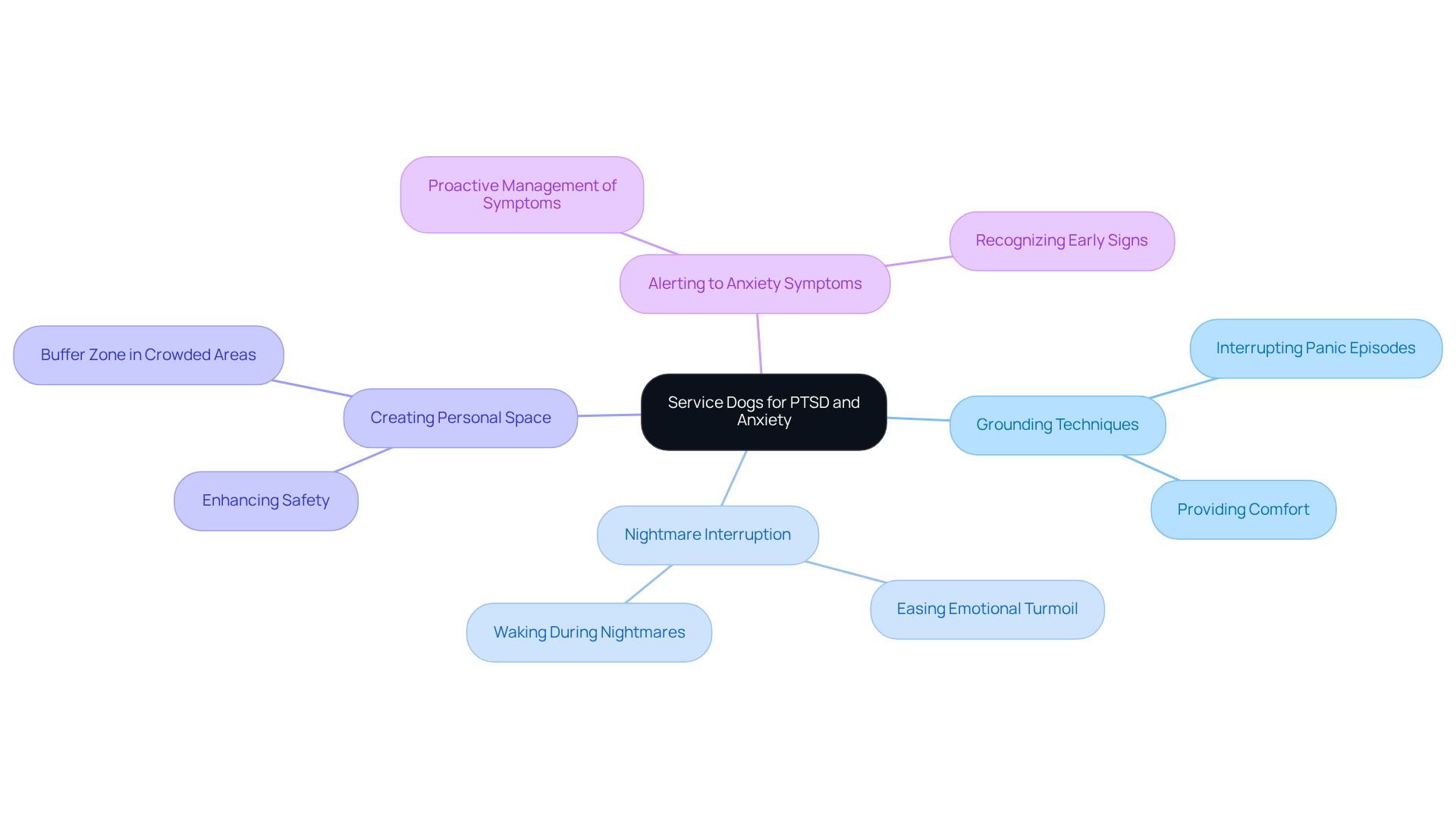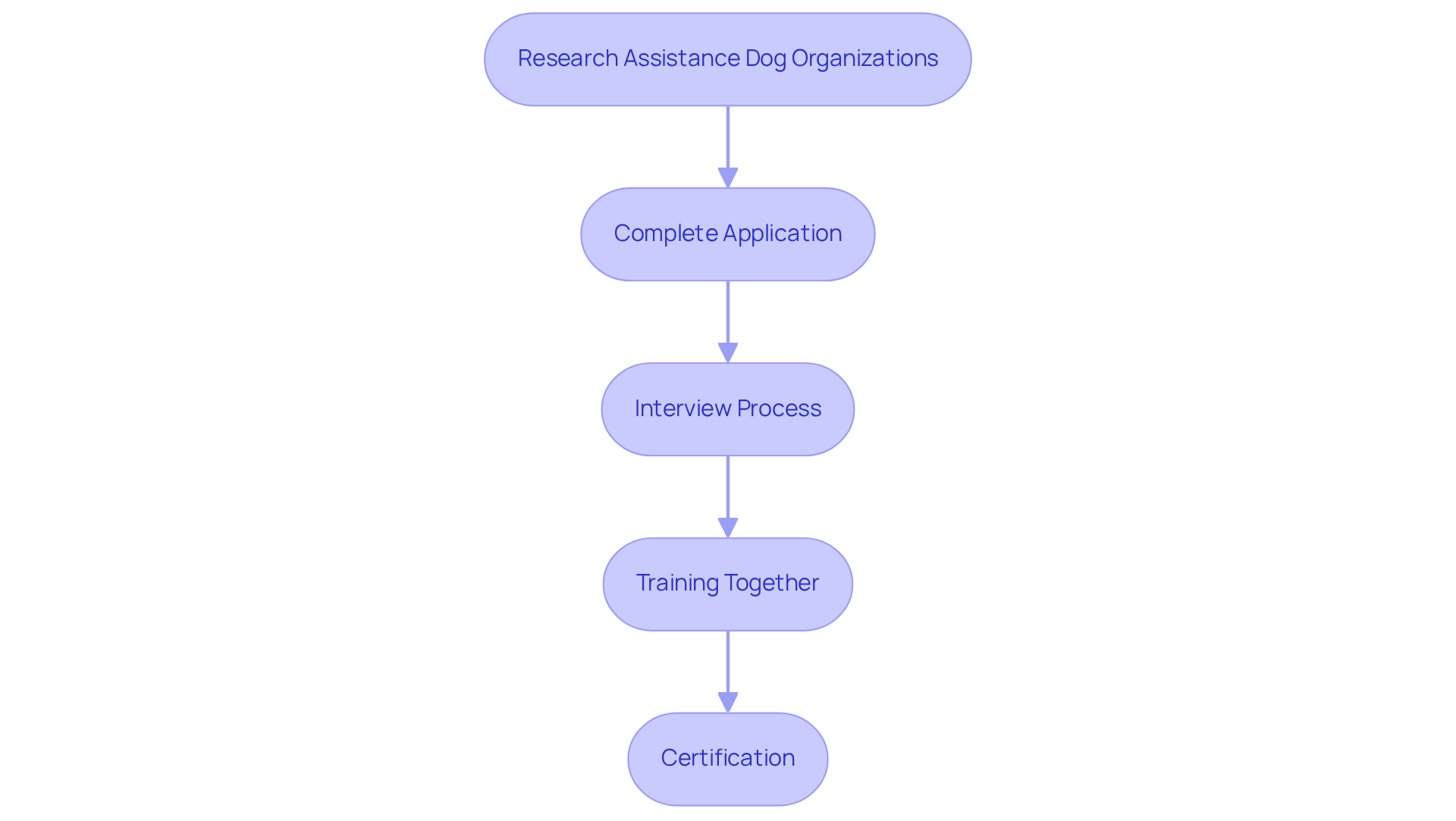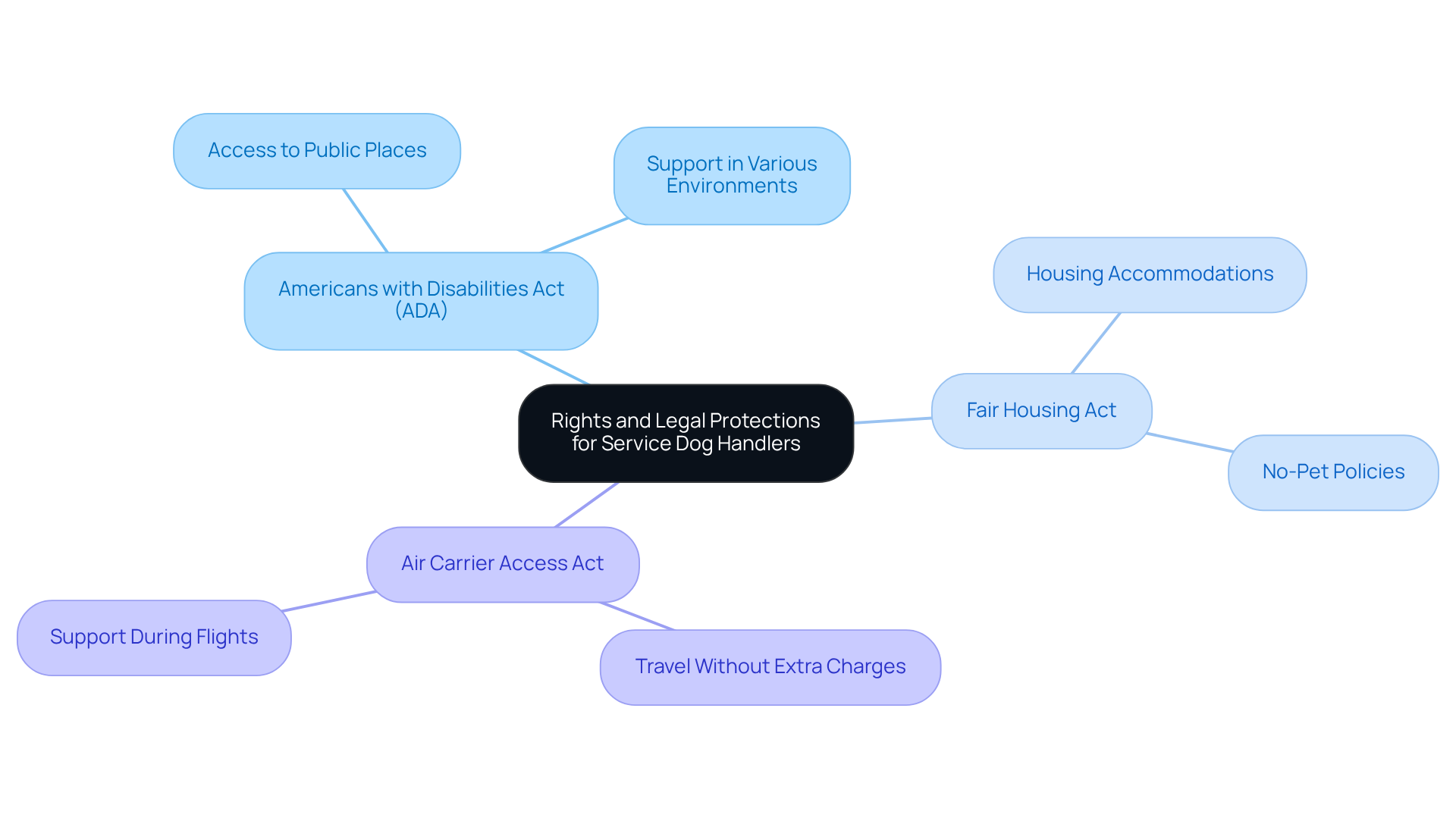

How to Get a Service Dog for PTSD and Anxiety: A Step-by-Step Guide
by Lena Park
Last updated: August 25, 2025
Verified and Approved by:
Angela Morris,
MSW, LCSW
Fact Checked

Overview
Acquiring a service dog for PTSD and anxiety is a journey that requires meeting specific eligibility criteria. Individuals must:
- Have a documented diagnosis
- Engage in ongoing treatment
- Possess the ability to care for their new companion
This process can feel overwhelming, but it’s important to know that you are not alone. Understanding the step-by-step approach to obtaining and training a service dog can provide clarity and hope.
Moreover, being aware of your legal rights and protections is crucial. Laws like the ADA ensure that service dog handlers have access to public spaces and housing accommodations. This knowledge not only empowers you but also helps in fostering a supportive environment for both you and your service dog.
Remember, this journey is about finding support and companionship that can significantly enhance your quality of life. You deserve to feel understood and cared for as you navigate these challenges.
Introduction
Understanding the profound impact of service dogs on mental health can truly be life-changing for those grappling with PTSD and anxiety. These specially trained companions provide not only support but also a vital pathway to reclaiming a sense of normalcy and security in daily life. Yet, the journey to acquiring a service dog often comes with its own set of questions and complexities.
- What are the eligibility requirements?
- How does one navigate the training and legal landscape to ensure a successful partnership with these remarkable animals?
These are important considerations that many face, and it’s essential to approach them with care and understanding.
Understand the Role of Service Dogs for PTSD and Anxiety
Assistance animals are specially trained companions that provide invaluable support to individuals with disabilities, especially for those who seek to understand how to get a service dog for PTSD and anxiety. These remarkable dogs engage in specific tasks that can significantly alleviate symptoms, such as:
- Grounding Techniques: Service dogs assist their handlers in staying present during anxiety attacks by nudging or applying pressure, effectively interrupting panic episodes and bringing comfort in distressing moments.
- Nightmare Interruption: Many assistance animals are trained to awaken their companions during nightmares, offering solace and easing the emotional turmoil associated with traumatic memories.
- Creating Personal Space: In crowded environments, assistance animals can establish a buffer zone, enhancing their owners’ feelings of safety and comfort.
- Alerting to Anxiety Symptoms: Certain dogs are trained to recognize early signs of anxiety, alerting their handlers so they can take proactive steps to manage their symptoms.
Research indicates that veterans with assistance animals face a 66% reduced likelihood of receiving a PTSD diagnosis compared to those without, underscoring the profound impact these animals can have on mental well-being. Furthermore, participants with assistance dogs reported a 3.7-point greater decrease in PTSD symptoms than those with emotional support dogs, emphasizing their effectiveness in therapeutic settings.
Bill Lins, a Marine Corps veteran, shared his heartfelt experience, stating that having his assistance dog Link has allowed him to reconnect with his family and better manage his emotions. He expressed, “[Link] has allowed me to become the father and husband I am supposed to be.” Understanding how to get a service dog for PTSD and anxiety is vital for anyone considering an assistance dog, as it emphasizes the potential for enhanced emotional well-being and improved daily functioning. Additionally, the growing body of scientific evidence, as noted by Dr. Maggie O’Haire, supports the use of assistance dogs in therapy, reaffirming their importance in the mental health landscape.

Determine Eligibility for a Service Dog
To understand how to get a service dog for PTSD and anxiety, individuals often face specific criteria that can feel overwhelming. It’s important to know that you are not alone in this journey. Here are some key requirements that may resonate with your experience:
- Diagnosis: It’s essential to have a documented mental health condition, such as PTSD or severe anxiety, confirmed by a licensed mental health professional if you want to know how to get a service dog for PTSD and anxiety. This validation is a crucial step in your path.
- Ongoing Treatment: Many programs encourage you to be actively engaged in therapy or counseling to manage your condition. This ongoing support can be a lifeline.
- Ability to Handle an Assistance Dog: Applicants should demonstrate the physical and emotional capacity to care for and manage an assistance dog independently. This responsibility can be daunting, but it’s also a rewarding journey.
- Age Requirement: Most organizations require applicants to be at least 18 years old, which can be a significant milestone in your life.
Understanding how to get a service dog for PTSD and anxiety is just the beginning. It’s also vital to comprehend the legal rights of assistance dog owners under the Americans with Disabilities Act (ADA). As an assistance dog owner, you will have complete public access rights, allowing you to bring your assistance dog into public areas like restaurants, shops, and public transit. You are also entitled to housing accommodations, even in places where pets are typically restricted.
Moreover, all support animals must be harnessed, leashed, or tethered unless it disrupts their tasks or your disability. Enrolling with the Disability Access Office (DAO) and finalizing an animal agreement form is crucial. This process involves submitting vaccination records and a photo of your animal. Gathering necessary documentation, such as a letter from your therapist or psychiatrist, is essential to support your application. Remember, this journey may be challenging, but there is support available to guide you every step of the way.

Follow the Steps to Acquire and Train Your Service Dog
The journey of acquiring and training a service dog is significant, especially when learning how to get a service dog for PTSD and anxiety, filled with hope and support. Here are several key steps to guide you through this process:
-
First, it’s essential to research assistance dog organizations. To learn how to get a service dog for PTSD and anxiety, seek out reputable groups that specialize in training assistance dogs. Take the time to read their reviews and understand their success rates; this can make a significant difference in your experience.
-
Next, you will need to complete an application. This involves filling out the application form provided by the organization, which includes your medical documentation and personal information. Remember, you will also need to register with the Disability Access Office (DAO) and complete an animal agreement form. This form requires submitting vaccination records and a photo of the animal, so be prepared.
-
As you move forward, be ready for the interview process to understand how to get a service dog for PTSD and anxiety. This is an important step where you can discuss your needs and learn how to get a service dog for PTSD and anxiety to support you. Sharing your story can help the organization understand your situation better.
-
Once you are matched with a dog, you will typically begin training together. This training is crucial and may include:
- Basic obedience commands
- Specific tasks related to your condition
- Public access training to ensure your dog behaves appropriately in various environments.
-
Finally, after successful training, your assistance dog may receive certification. This certification can be beneficial in accessing public spaces and housing, giving you greater freedom and support.
Training can take several months, and ongoing practice is essential to maintain your dog’s skills. Remember, this journey is not just about training a dog; it’s about building a partnership that can significantly enhance your quality of life.

Know Your Rights and Legal Protections with Service Dogs
As a service dog handler, you possess specific rights and protections under the law, which can be a source of comfort and assurance.
The Americans with Disabilities Act (ADA) is a federal law that allows service dogs to accompany their handlers in all public places, including restaurants, stores, and public transportation. These remarkable assistance animals undergo rigorous training to perform tasks directly related to their handler’s disability, ensuring they can provide effective support in various environments.
The Fair Housing Act is another important piece of legislation that safeguards individuals with disabilities from bias in housing. It permits assistance animals in no-pet accommodations, offering you the peace of mind that your needs will be respected. It’s crucial to have paperwork that confirms your dog’s designation as a support creature, as this documentation can help in situations where your rights might be questioned.
Additionally, the Air Carrier Access Act guarantees that assistance animals can travel with their handlers on flights without incurring extra charges, offering essential support during your journeys.
While it’s important to recognize that assistance canines are acknowledged under these laws, it’s equally vital to understand that emotional support animals do not possess the same legal protections. Always carry documentation verifying your dog’s status as a service animal, and be prepared to educate others about your rights and the significant training that service dogs undergo to assist individuals with disabilities.
Remember, you are not alone in this journey. The support available to you is profound, and understanding your rights can empower you to advocate for yourself and your beloved service dog.

Conclusion
Understanding the process of acquiring a service dog for PTSD and anxiety can be a transformative journey for individuals seeking support. It involves recognizing the profound role these trained companions play in enhancing emotional well-being and daily functioning. By navigating the necessary steps—from determining eligibility to training and understanding legal rights—individuals can empower themselves to significantly improve their quality of life.
Key insights from this guide highlight the essential tasks service dogs perform, such as:
- Grounding techniques
- Nightmare interruption
- Alerting to anxiety symptoms
The importance of ongoing treatment and documentation is crucial, as they lay the foundation for a successful application process. Legal protections under the Americans with Disabilities Act further ensure that service dog handlers can access public spaces and housing without discrimination, reinforcing the vital support these animals provide.
Ultimately, the journey to obtaining a service dog is not merely about acquiring an assistance animal; it is about fostering a partnership that can lead to healing and empowerment. For those considering this path, the potential benefits are immense. Taking the first steps toward acquiring a service dog can open doors to a more manageable and fulfilling life, making it imperative to seek out the necessary resources and support along the way.
Frequently Asked Questions
What is the role of service dogs for individuals with PTSD and anxiety?
Service dogs provide invaluable support by engaging in specific tasks that alleviate symptoms, such as grounding techniques, nightmare interruption, creating personal space, and alerting to anxiety symptoms.
How do service dogs assist during anxiety attacks?
Service dogs assist their handlers during anxiety attacks by nudging or applying pressure, which helps interrupt panic episodes and brings comfort in distressing moments.
Can service dogs help with nightmares?
Yes, many assistance animals are trained to awaken their companions during nightmares, providing solace and easing the emotional turmoil associated with traumatic memories.
What is the benefit of service dogs in crowded environments?
Assistance animals can create a buffer zone in crowded environments, enhancing their owners’ feelings of safety and comfort.
How do service dogs alert their handlers to anxiety symptoms?
Certain dogs are trained to recognize early signs of anxiety and alert their handlers, allowing them to take proactive steps to manage their symptoms.
What does research say about the effectiveness of assistance animals for veterans?
Research indicates that veterans with assistance animals have a 66% reduced likelihood of receiving a PTSD diagnosis compared to those without, highlighting the significant impact these animals can have on mental well-being.
How do assistance dogs compare to emotional support dogs in terms of PTSD symptom reduction?
Participants with assistance dogs reported a 3.7-point greater decrease in PTSD symptoms than those with emotional support dogs, demonstrating their effectiveness in therapeutic settings.
What personal experience did Bill Lins share about his service dog?
Bill Lins, a Marine Corps veteran, shared that having his assistance dog Link has allowed him to reconnect with his family and better manage his emotions, stating that Link has helped him become the father and husband he is supposed to be.
Why is it important to understand how to get a service dog for PTSD and anxiety?
Understanding how to get a service dog is vital for anyone considering an assistance dog, as it emphasizes the potential for enhanced emotional well-being and improved daily functioning.
What does Dr. Maggie O’Haire’s research indicate about assistance dogs?
Dr. Maggie O’Haire’s research supports the use of assistance dogs in therapy, reaffirming their importance in the mental health landscape.
Certify Your Emotional Support Animal Today

Why You Can Rely on Us?
At Wellness Wag, we believe your pet deserves care rooted in both science and compassion. Each article is carefully researched, written in clear language for pet owners, and then reviewed by qualified professionals to ensure the information is evidence-based, current, and practical for real-life care. Our goal is to help you feel confident in making informed decisions about your pet’s health and well-being.
Reviewed by
Angela Morris, MSW, LCSW
Angela is a licensed clinical social worker with 20 years of experience in patient advocacy and community mental health. She has assisted numerous clients with ESA evaluations and brings a deep understanding of disability accommodations, ensuring that all information is accurate, supportive, and practical.

Written by :
Lena Park
Last Updated :
August 25, 2025












